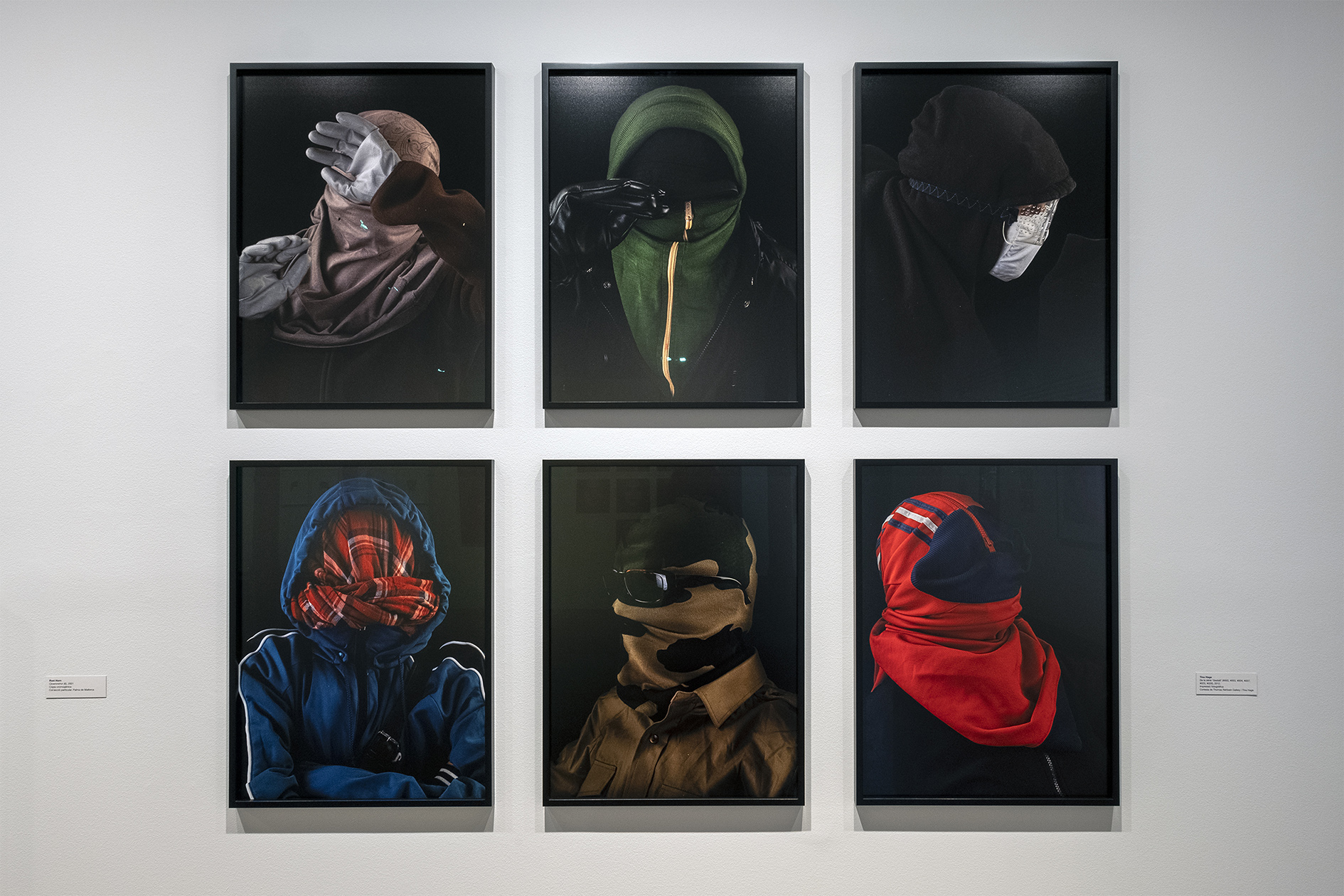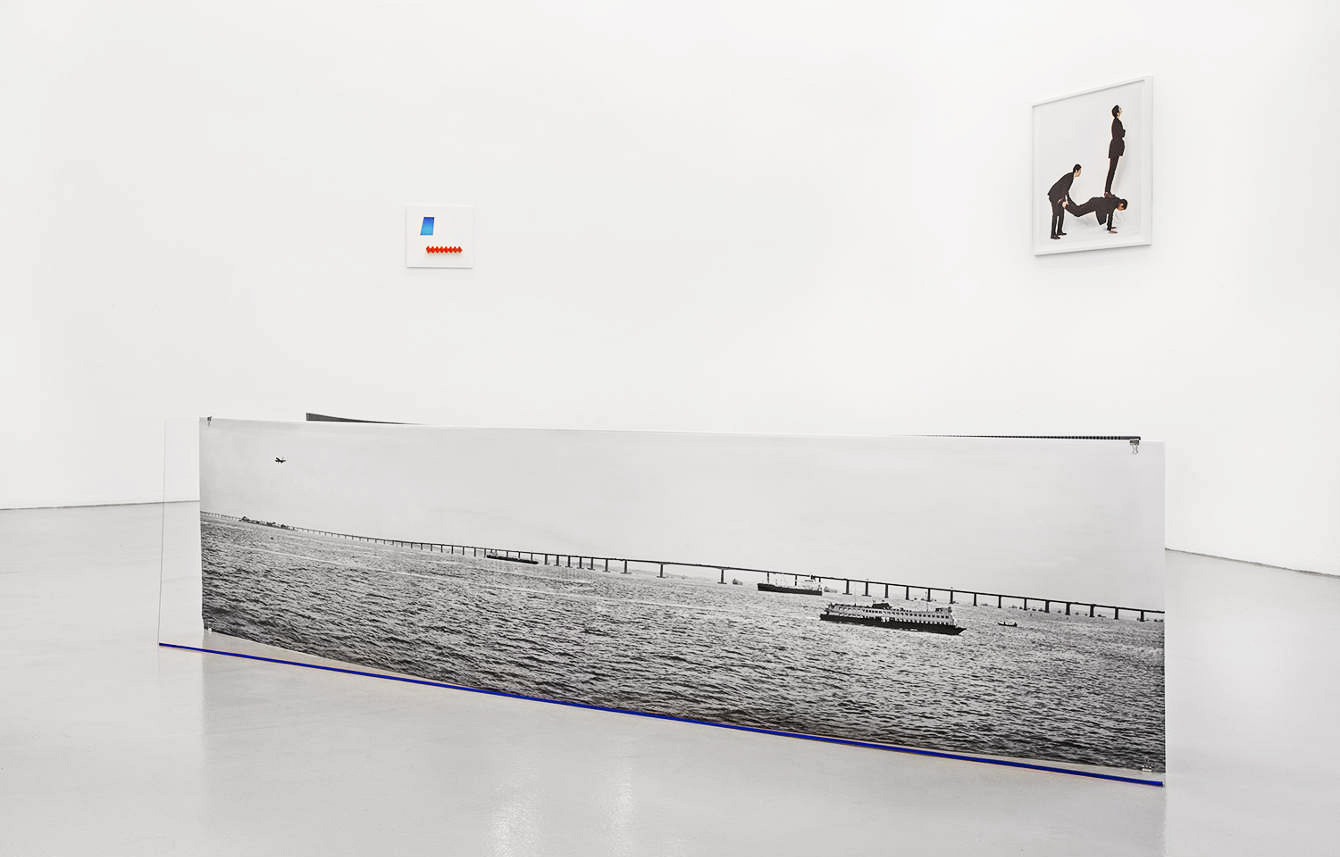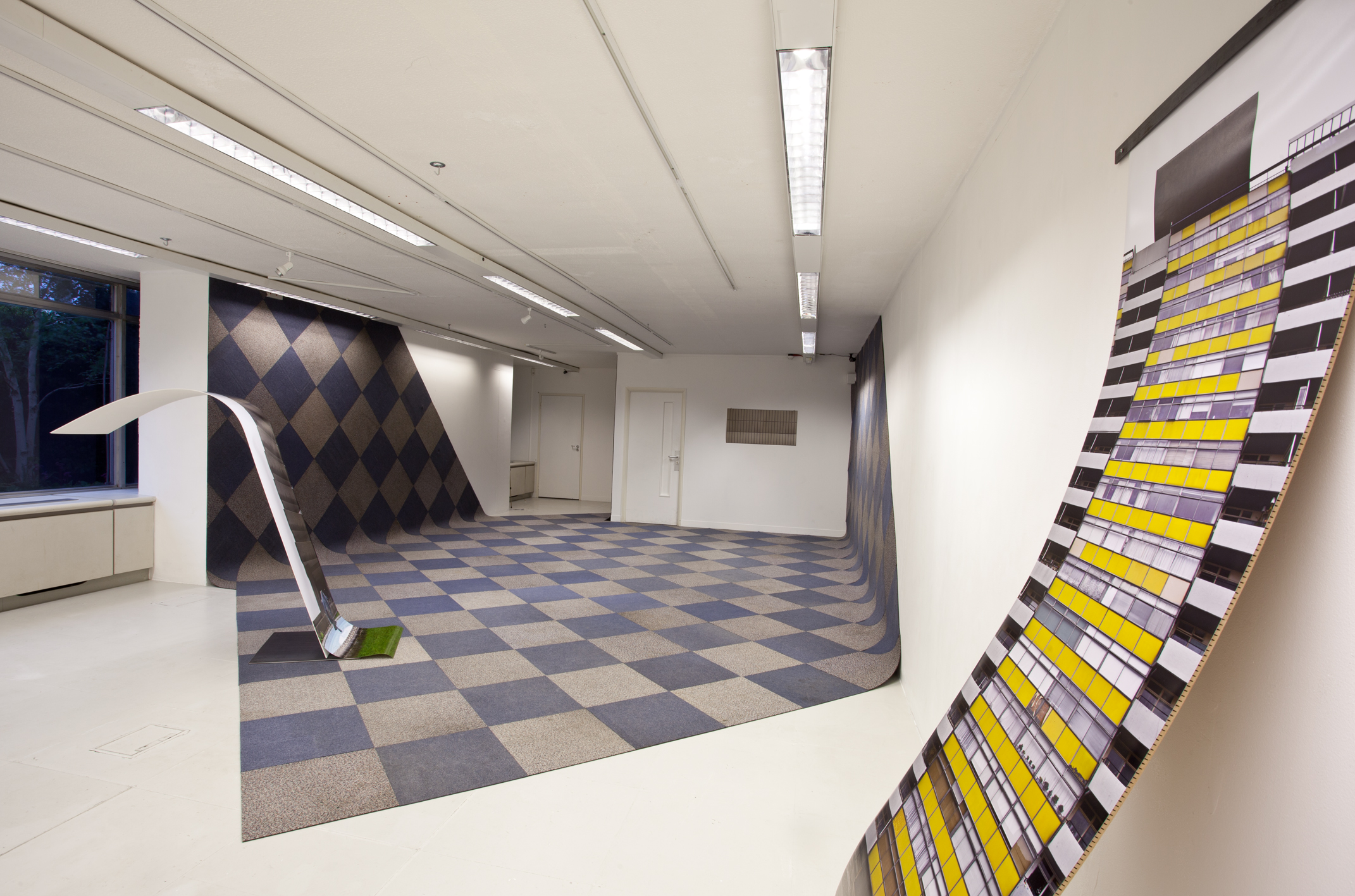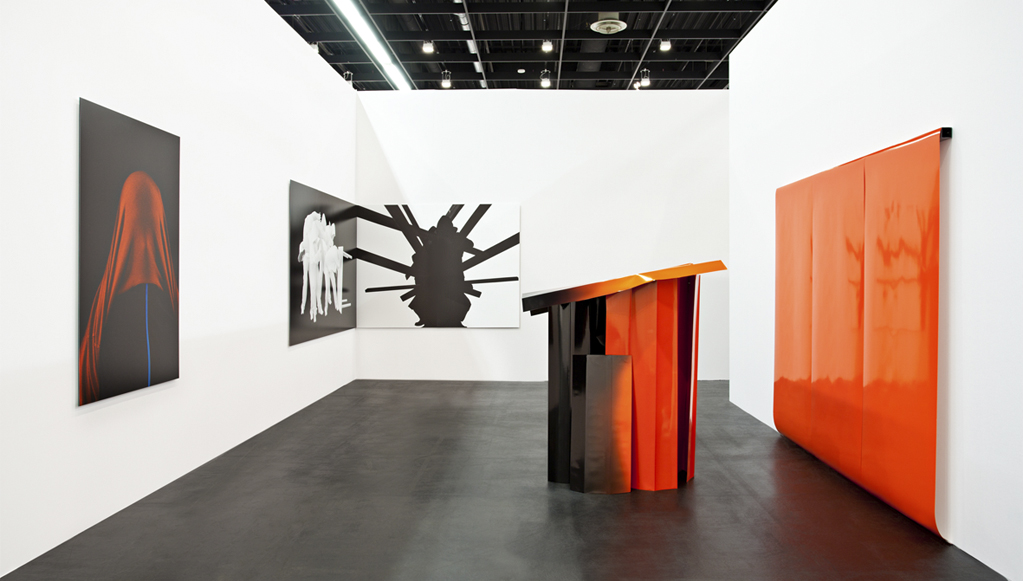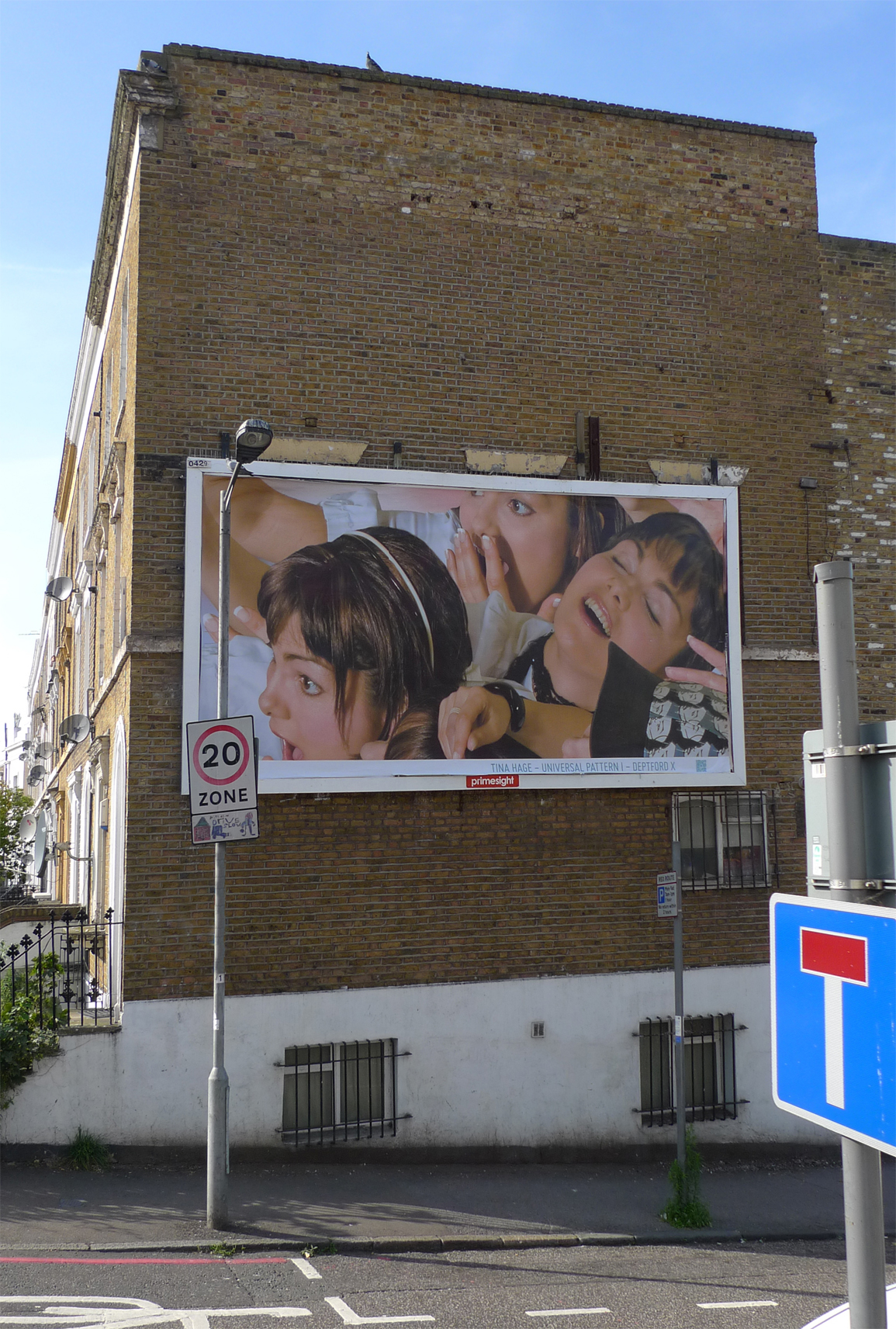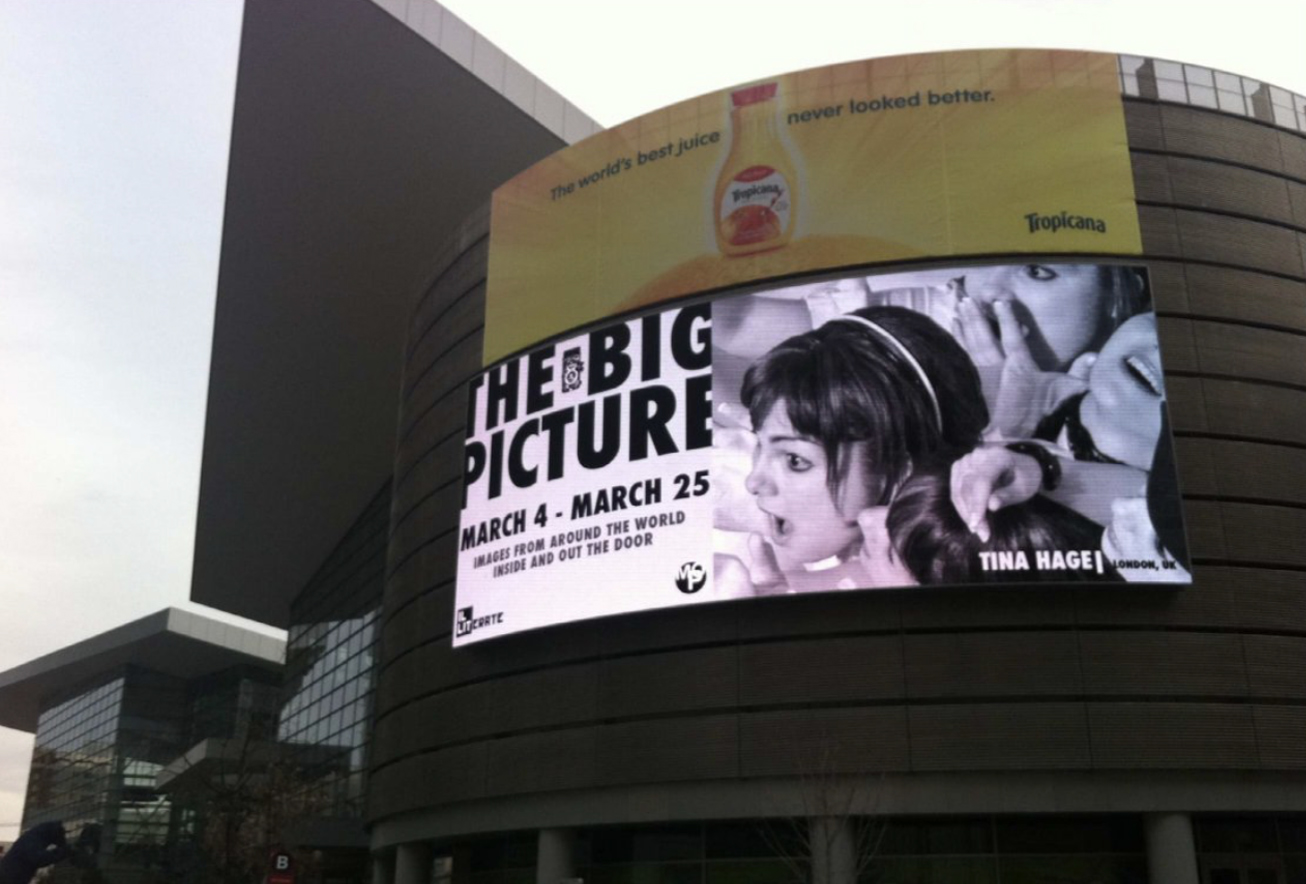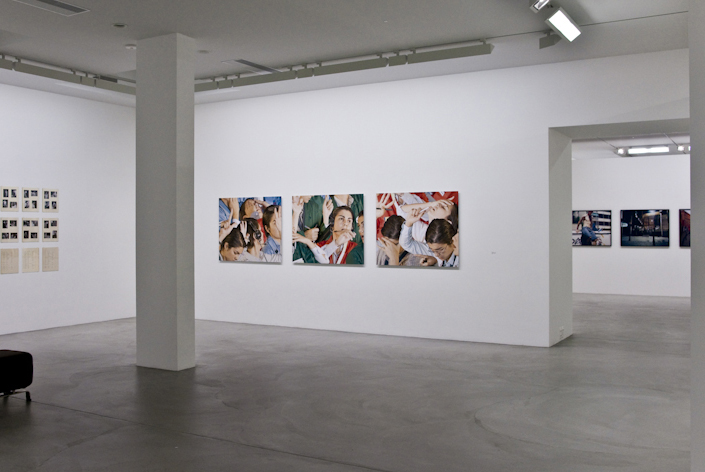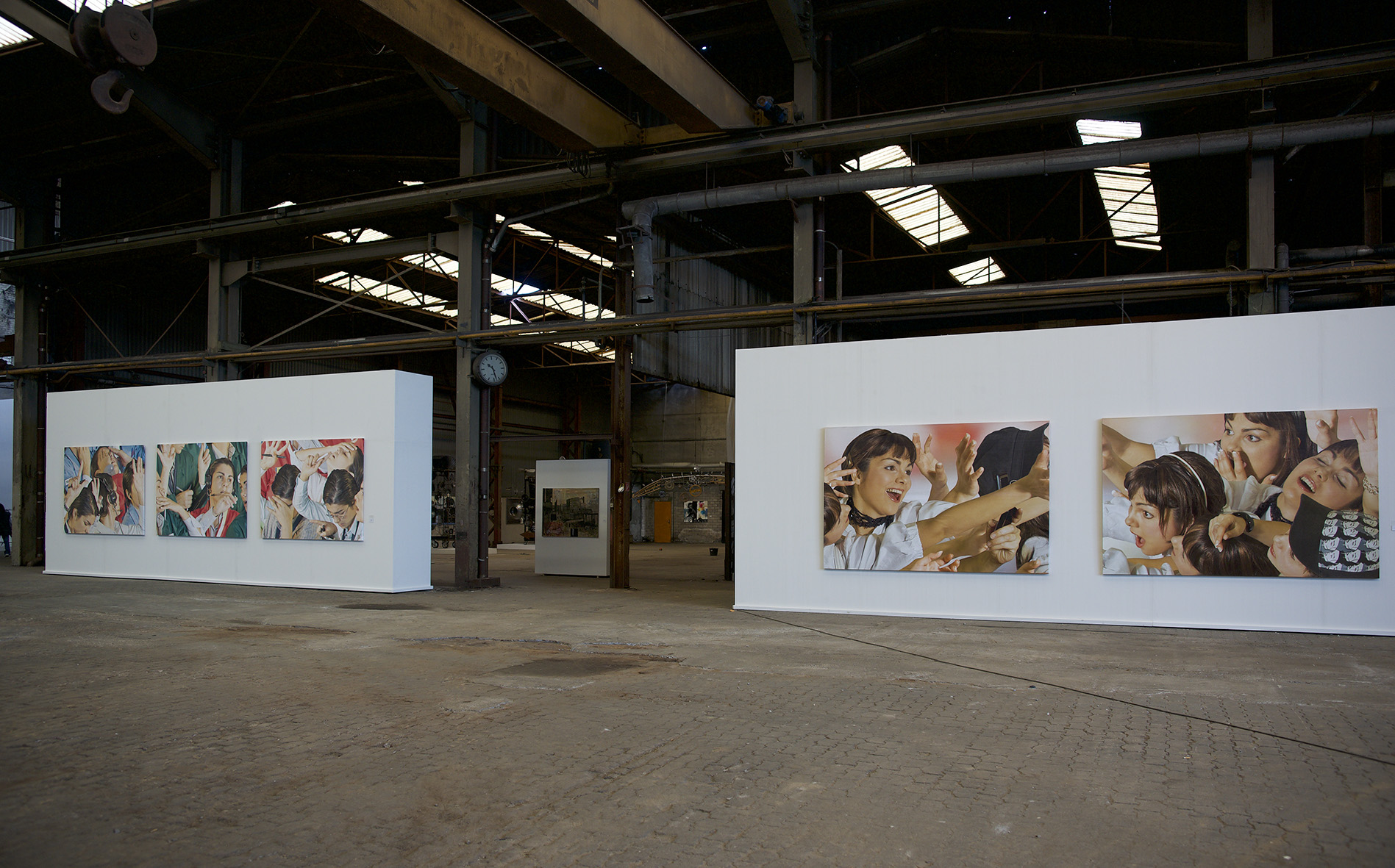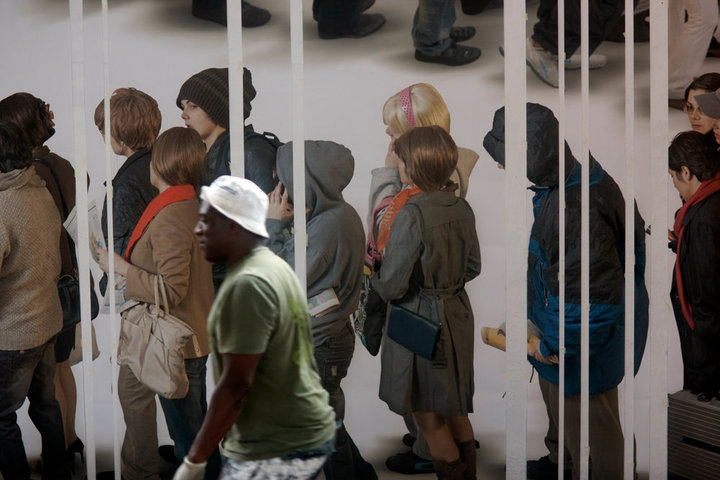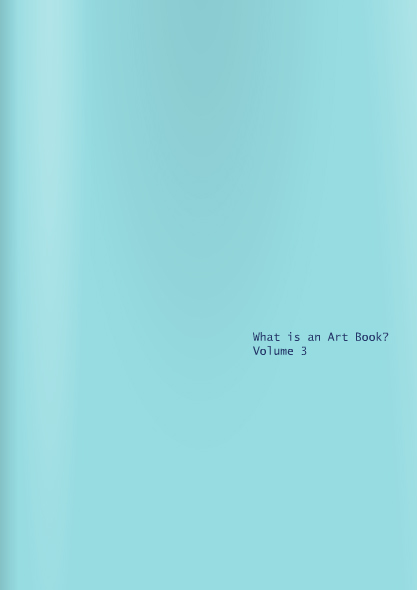German
Newspaper article in the FAZ (2025)
Group show “The Conversations” at H8H.space, Frankfurt May 2025
>> Link to installation shots of work in group show “The Conversations”
Translation
Blind Dates and Dialogues – “The Conversations” at H8H.space, Frankfurt
At least the artists were asked. After all, it doesn’t hurt to know what you're getting into when a small curatorial team invites you to a blind date. With artists, some from London, some from Frankfurt, who mostly only knew of each other by reputation before the exhibition titled “The Conversations.” It’s a rather appealing experimental setup, one might say — and perhaps not even the curators Jochem Hendricks, Keh Ng, Tina Hage, and Matthew Stock knew whether and what the pairings brought together in the H8H.space would have to say to one another.
And yet, even though Hendricks’ conceptual sound piece here and Demi Spriggs’ Exercise in Folklore there are connected by little more than their analog medium; even though it’s hard to reconcile Jagoda Bednarsky’s painting with Keh Ng’s Beast of Hackney Marshes; and even though Warren Garland initially appreciated Dirk Krecker’s collages primarily as a backdrop for his own video work — the concept largely works.
This is less a matter of form or preferences and more a result of the respective artistic attitudes, as is evident, for instance, in Karl England’s Variable and Thuy Tien Nguyen’s Platform. It also stems from the audacity with which, for example, Blue Curry sarcastically questions the identity discourse in art — paying homage in doing so to the bravado of one-time enfant terrible Georg Herold.
The initiated dialogues prove especially stimulating in their juxtaposition of younger and more established positions. More than five decades separate the minimalist “reliefs” of Charlotte Posenenske and the photography-based work of Tina Hage, born in 1976. And in the realm of art, that’s more than just half a lifetime — it’s a world apart.
Here, however, the artistic positions truly have something to say to each other. They are not simply talking past one another.
— Christoph Schütte
“The Conversations” at H8H.space, Frankfurt, Hohenstaufenstraße 8. On view until May 16.
Interview on Tique (2024)
Tique is a publication on contemporary art that exists both in print and online. Link.
German
Artikel (Auszug) von Antje Merke (2022)
Schwäbische Zeitung
Der gesamte Artikel ist hier zu lesen.
German
Artikel von Magrit Haas (2022)
Südwest Presse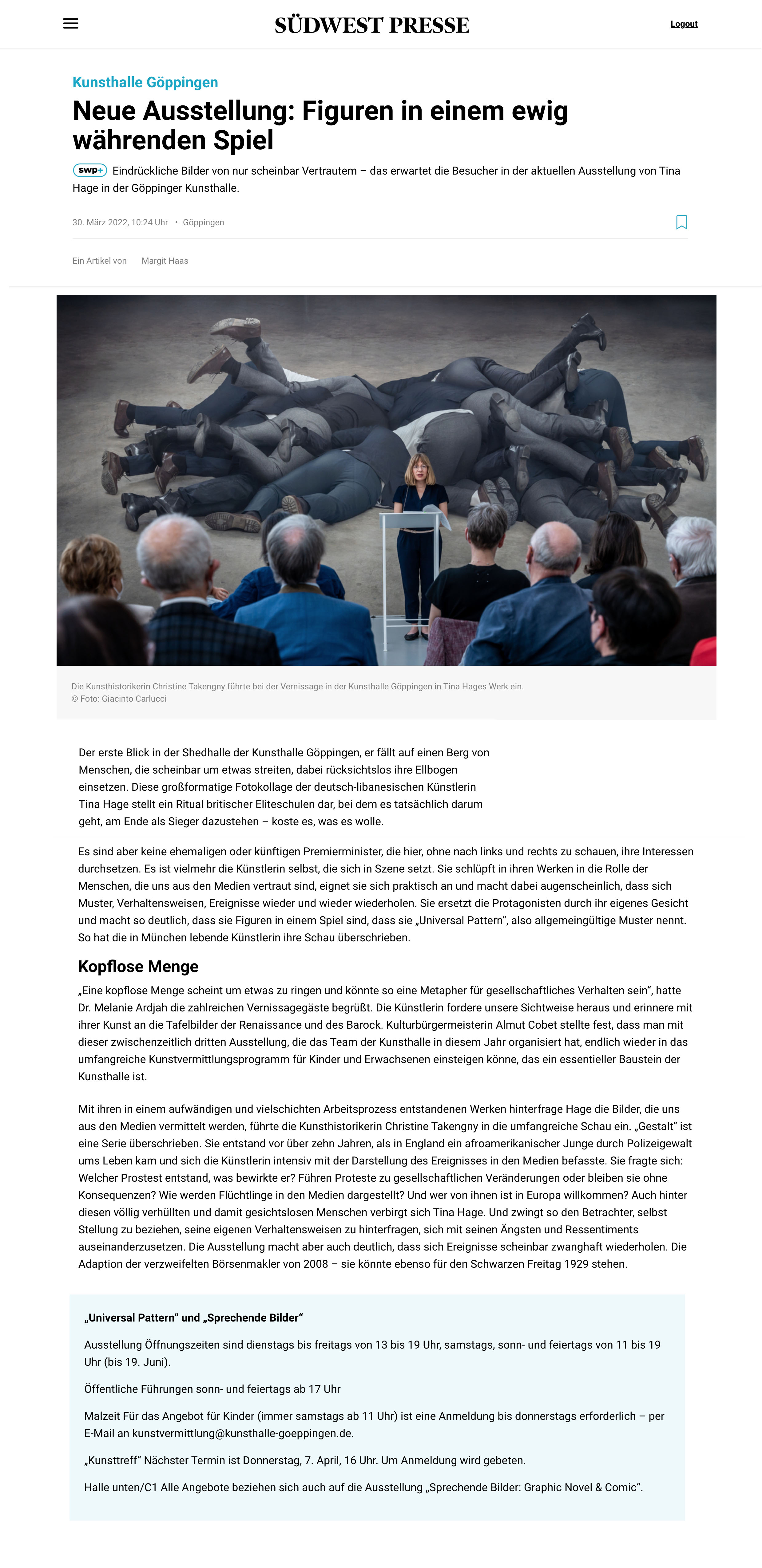
German
Artikel im Filstalexpress (2022)

Fotos from guided tours with pupils at the show Universal Pattern at Kunsthalle Göppingen (2022)
Fotos by Dr. Melanie Ardjah
German
Artikel von Damian Zimmermann (2021)
Kölner Stadt-Anzeiger
Der Artikel als PDF hier.
Article by Uma Karavadra (2020)
On Contemporary Art Society / Artist to Watch
Conceived initially as a part of the London based collaborative event by the Mews Project Space 'Artists books Weekend' “What is an Art Book?” is an investigation in to the politics of artists books, its mode of production and its recent resurgence in the art world. For this our third volume The Modern Language Experiment is very excited to be collaborating with two New York spaces. Garis & Hahn and Young & Starving. An Art Book today can be seen to occupy various different positions including that of a piece of theory, a catalogue, a printed exhibition, a piece of art in itself, a supplement to a pre-existing piece. It can be a proposal for the future or an examination of the present or what has passed. “What is an Art Book?” will be an investigation of what an Art Book is in terms of material, conceptual, industrial and political concerns. For more information visit The Modern Language Experiment web site.
![]()
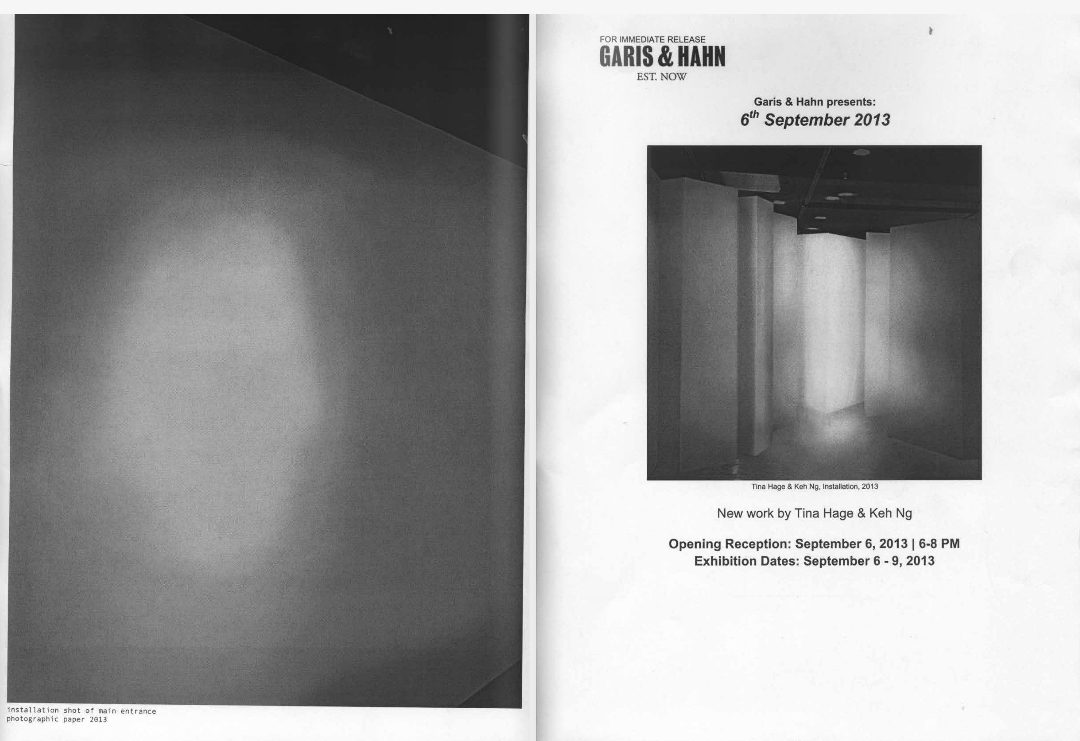
HESA imprint / Issue 20 (2012)
ArticleThe series Red Carpet was published in the magazine HESA imprint in September 2012.
Twentieth issue of art magazine HESA imprint, "Koodi - Code" including work by Tina Hage, Alban Low, Daniel Bourke, Pascal Brateau, Vanessa Chong, Jon Gourley, Tracy Piper-Wright, Caroline Underwood. To see the whole magazine please click here.
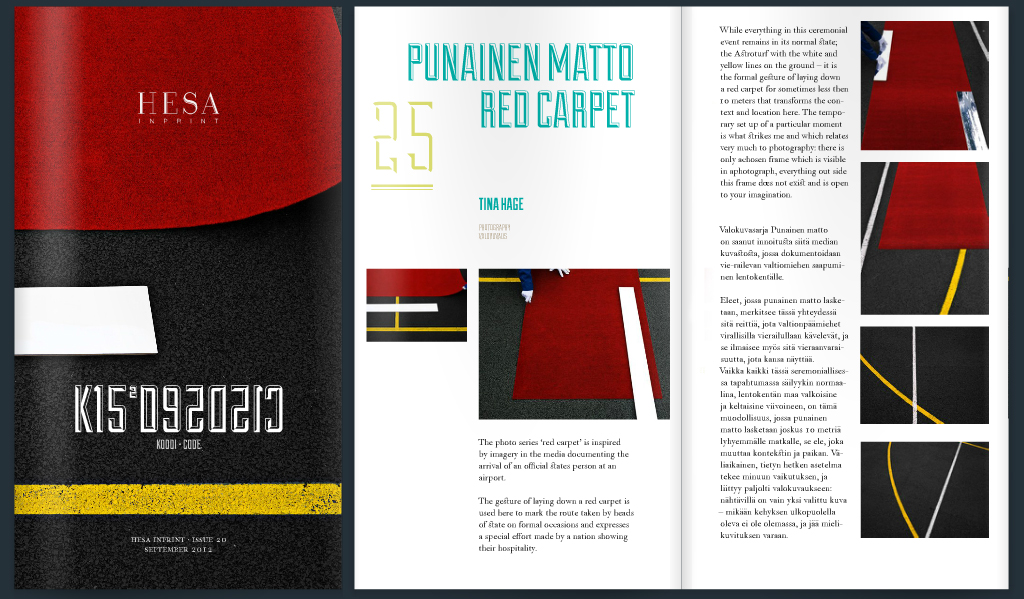
Aesthetica magazine (2012)
Interview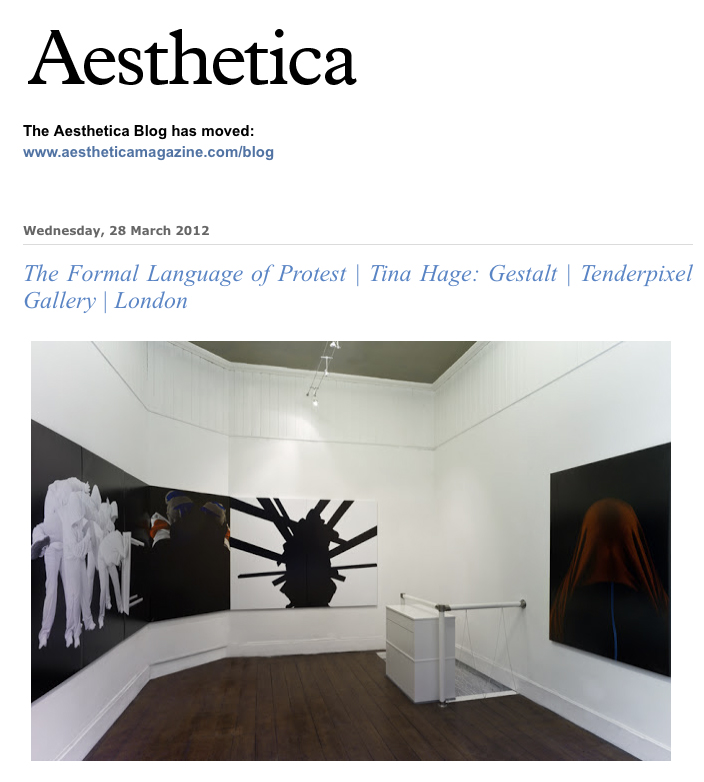 BR: Tell me about Gestalt. What are the bare bones of the project and where did it begin?
BR: Tell me about Gestalt. What are the bare bones of the project and where did it begin?TH: My work starts with found images particularly those from newspapers and online media. I often look at journalistic images and have amassed a large collection of these, so I have become very aware of the various uprisings in different countries that have sprung up since the end of 2010.
What interests me is that all the protesters from these diverse places appear to be people on the street as opposed to seasoned activists and are self-organised. However, the actions of the UK rioters cannot been seen in the same context as the protesters in Egypt for example.
There is clearly an unplanned movement of masses in a swarm like mentality which uses social media and networking to communicate. The result of this is an almost spontaneous physical presence on the street. The protesters are mostly anonymous; there is no confirmed leader and most of the time the faces we see in the media are completely covered.
It is important to mention that this work is not about the subject of protest, but rather the formal language that these protesters start to create. Until recently, protests were usually pre-organised with defined leaders and political agendas. The language emerging from these new protests represent a different way in which masses now form. It is one of anonymity and viral chaos.
BR: What can we expect to see from the new work and what reaction do you anticipate from audiences to the show?
TH: When you step into the gallery space, you are physically standing inside the work. The photographic installation is made of large format prints on panels, set up very closely next to each other. The other element of the show is a book, containing images in the exhibition and additional works from the series. It creates rhythm, movement and patterns by juxtaposing the images next to each other in the page layout. Both elements are important to the show because they broaden the context of the work. The show and the book are not a political statement about protesting, I am more interested in looking closely at the anonymous individual and how they emerge as part of a movement; their gestures, appearance and actions. I would like the audience to discover a visual language that lets in their own association towards the work. I did not want to produce work which can be put into a distinct category, I always feel that restricts ways of thinking and new associations. I am fascinated by these current movements across the globe and I would like to contribute to see the individual in other aspect besides the greater political movement they are part of.
To read the full interview please click here
It is important to mention that this work is not about the subject of protest, but rather the formal language that these protesters start to create. Until recently, protests were usually pre-organised with defined leaders and political agendas. The language emerging from these new protests represent a different way in which masses now form. It is one of anonymity and viral chaos.
BR: What can we expect to see from the new work and what reaction do you anticipate from audiences to the show?
TH: When you step into the gallery space, you are physically standing inside the work. The photographic installation is made of large format prints on panels, set up very closely next to each other. The other element of the show is a book, containing images in the exhibition and additional works from the series. It creates rhythm, movement and patterns by juxtaposing the images next to each other in the page layout. Both elements are important to the show because they broaden the context of the work. The show and the book are not a political statement about protesting, I am more interested in looking closely at the anonymous individual and how they emerge as part of a movement; their gestures, appearance and actions. I would like the audience to discover a visual language that lets in their own association towards the work. I did not want to produce work which can be put into a distinct category, I always feel that restricts ways of thinking and new associations. I am fascinated by these current movements across the globe and I would like to contribute to see the individual in other aspect besides the greater political movement they are part of.
To read the full interview please click here
What is an Art Book? Volume 1 (2012)
Publication produced byThe Modern Language Experiment

What is an Artbook?
Published on Jun 20, 2012An Art Book today can be seen to occupy various different positions including that of a piece of theory, a catalogue, a printed exhibition, a piece of art in itself, a supplement to a pre-existing piece. It can be a proposal for the future or an examination of the present or what has passed.
“What is an Art Book?” will be an investigation of what an Art Book is in terms of material and conceptual concerns. It is a collaborative project that will be produced during the Artist Books Weekend at the Mews Project Space.


Artists, writers, curators, designers and other practitioners are invited to respond to the title of the project by contributing their interpretation of what an Art book means to them and their practice. Each contributor can propose text, drawings, photographs, sculpture, performance, audio recordings, video or any other concept/theory as long as it can ultimately be realised in A4 paper format and in black and white.
Tina Hage // Gestalt (2012)
PublicationThe publication contains artworks of the series 'Gestalt' and a text by Keh Ng (The modern language experiment). It was produced in context of Tina's solo show at Tenderpixel Gallery in February 2012.
It is currently available at blurb.

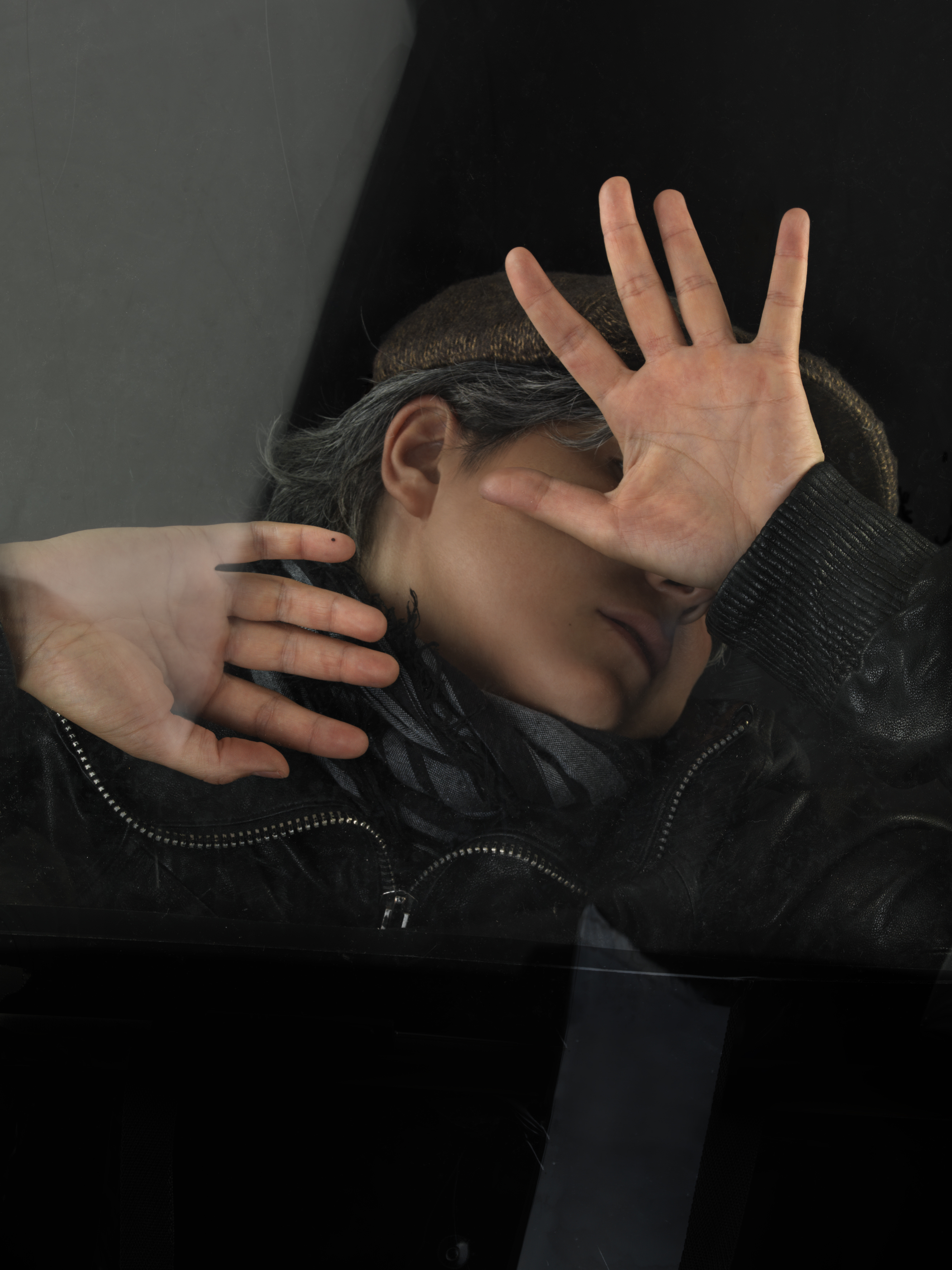
There will be others (2012)
Publication made for the group show 'There will be others' at Angus Hughes GalleryThe publication was produced by The Modern Language Experiment. The booklet contains works by the participating artists and writing by Paul O'Kane and Duncan Wooldridge.

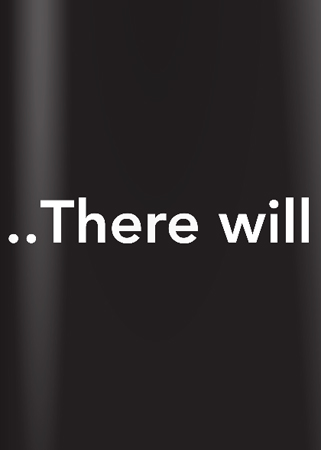
Arbeit/Labour (2010/11)
Press articles for the show Arbeit/Labour at the Fotomuseum Winterthur (2010/11) Press articles Tina Hage's work is mentioned in (all in German):
Press articles Tina Hage's work is mentioned in (all in German):> Kultur Online: click here for online article / pdf format
> P.S. Zuerich: click here for pdf format
> Money Cab: click here for pdf format
Catlin Guide (2010)
Publication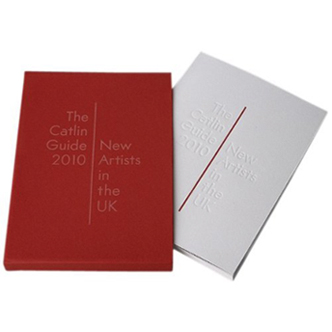
The Catlin Guide is an elegant, limited edition collection of artist profiles, introducing the 40 most promising new graduate artists in the UK. Printed annually, each edition exhibits the artists’ latest work and details future exhibitions, projects and aspirations for the coming year.
Artists featured in the inaugural edition of The Catlin Guide, published in 2010, were recommended by a wide survey of BA and MA course leaders, independent curators, gallerists and collectors, moving it towards its current reputation as an accurate and exciting overview of new British art.
Artists featured in the inaugural edition of The Catlin Guide, published in 2010, were recommended by a wide survey of BA and MA course leaders, independent curators, gallerists and collectors, moving it towards its current reputation as an accurate and exciting overview of new British art.
Stimulus Respond Magazine (2010)
Issue Circus
The article consist of Tina Hage's current work and a text by curator Rahila Haque
> Click here for full view of magazine
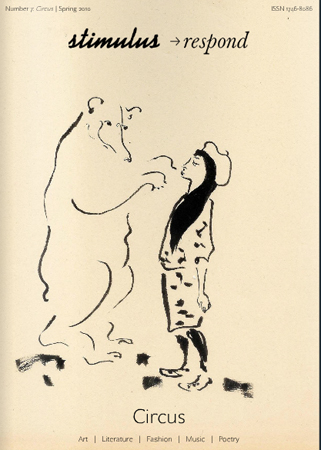
Flexible Aura (2009)
Exhibition catalogue & curatorial project Seoul/London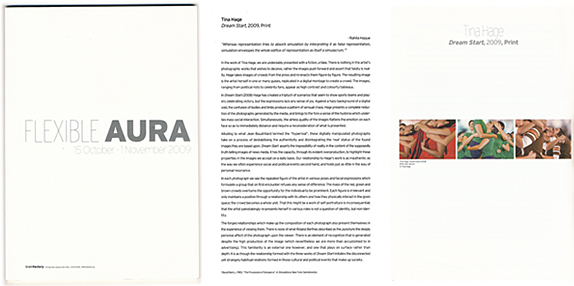
The publication was part of the group show Flexible Aura held at Brain Factory project space in Seoul, South Korea. The catalogue and exhibition were curated by Byeon Hyun-joo and Christine Takengny.
> Click here for pdf format of publication
> Korean Times: click here for online review of the show
> Click here for pdf format of publication
> Korean Times: click here for online review of the show
The Guardian (2009)
The next generation of YBAs: What does the future hold?
Newspaper article
> The Guardian: click here for the online article
(pdf format of printed newspaper article)

KIC -NordArt (2009)
Press article

Tina Hage's work was part of the exhibition NordArt which is held at Kunstwerk Carlshütte in Büdelsdorf, North Germany.
Since 1999 the NordArt has established itself as one of the largest exhibitions of contemporary art in Europe which takes place anually in the summer months. The NordArt is an overall work of art in its own right and is designed as such each year. More than 200 international artists, selected by a jury, present a comprehensive panorama of contemporary art.
Since 1999 the NordArt has established itself as one of the largest exhibitions of contemporary art in Europe which takes place anually in the summer months. The NordArt is an overall work of art in its own right and is designed as such each year. More than 200 international artists, selected by a jury, present a comprehensive panorama of contemporary art.
Based in Munich
Education
2009 Master in Fine Arts at Goldsmiths College, London, UK
2003 Professional Practicum, College of Fine Arts Sydney, Australia
2004 Diploma in audio visual studies at the Academy of Media Arts, Cologne, Germany
Solo exhibitions
2022 Universal Pattern, Kunsthalle Göppingen, Germany
2021 The one that couldn’t get away, Thomas Rehbein Gallery, Cologne, Germany
2015 Infinite Gesture, Thomas Rehbein Gallery, Cologne, Germany
The Place Here, Object / A Gallery, Manchester, UK
2013 New Positions, ArtCologne, Thomas Rehbein Gallery, Cologne, Germany
Presence, Ku Gallery, Taipei, Taiwan
2012 Gestalt, Tenderpixel Gallery, London, UK
2010 Tina Hage, LoBe - London Berlin Art Kunst, Berlin, Germany
2009 Two Positions, Thomas Rehbein Gallery, Cologne, Germany
2004 dial:ogee, Moltkerei Werkstatt, Cologne, Germany
2003 Erika, KHM, Cologne, Germany
Group exhibitions
2025 The Conversations, H8H.space, Frankfurt a. Main, Germany
2024 Prolouge (to the conversation), H8H.space, Frankfurt a. Main, Germany
Dear Future Me. Thomas Rehbein Gallery, Cologne, Germany
Essex Neck curated by TMLE at Sluice expo, Colchester, UK
2023 Relax, BBK-Ausstellung, Galerie der Künstler*innen, Munich, Germany
Showroom, Wiede Fabrik, München, Germany
2022 Shaping Protest, Museum Ulm, Germany
Athens Photo Festival 2022, Benaki Museum / Pireos 138, Athen, Greece
Territory, curated by TMLE at Sluice expo, Lisbon, Portugal
2021 Face Control, Foto Colectania, Barcelona, Spain
2019 Eine Mauer aus fliessenden Wasser, KUNST BLOCK BALVE, Munich, Germany
2018 25 YEARS! SHARED HISTORIES, SHARED STORIES, Fotomuseum Winterthur, Switzerland
2017 Screening: Zero Recoil Damage, part of the Folkestone Fringe Triennial, Silver Screen Cinema, UK
Normal? Festival / Folkestone Quarterhouse, Whelkboy Gallery, Folkestone, UK
Untitled, Sassoon Gallery, Folkestone Library Museum, UK
2016 Now for Tomorrow II, Nottingham Castle Museum, Nottingham, UK
2015 Frame thy Fearful Symmetry, Collyer Bristow Gallery, London, UK
Die Stadt die es nicht gibt, cityleaks, Cologne, Germany
The Open West, The Wilson Museum & Gallery, Cheltenham, UK
2014 Trialogues by Peer Session, ASC Gallery, London UK
Tijdsdocument by Eddie The Eagle Museum, Tolhuistuin, Amsterdam, Holland
UH-LA-LARGO, Largo das Artes, Rio de Janeiro, Brazil
2013 What is an Art Book? Vol.3, TMLE, Garis & Hahn Gallery, NYC, US
The Big Picture, Illiterate Gallery, Denver, US
2012 Impel and the Procession, Ku Gallery, Taipei, Taiwan
Preposterous, La Scatola Gallery, London, UK
There will be others, TMLE, Angus-Hughes Gallery, London,UK
2011 Waiting for Suicidal Hares, International Video Art Festival, Moon Event Space, Chongqing, China
What is an Art Book?, TMLE, The Mews Project Space, London,UK
Deptford X, London, UK
The Wolfson Syndrome, The Modern Language Experiment, London, UK
Simulacrum, Moon Gallery, Hong Kong
The Big Picture, Illiterate Gallery, Denver, US
2010 Arbeit / Labour, Fotomuseum Winterthur, Switzerland
Shift Work, Art Under The Westway, London, UK
Deceit as part of the ‘Hackney Wicked’ Festival, London, UK
Down the road of Globalisation, The Crypt, St Martin’s in the Fields, London, UK
Bay View, Bay Gallery, London, UK
Ways of Seeing, I-MYU Projects Gallery, London, UK
2009 Exposure, TAP, Southend on Sea, UK
NEU/NOW online Festival, Vilnius, Lithuania
Flexible Aura, Brain Factory, Seoul, South Korea
Jamais vu as part of the ‘Hackney Wicked’ Festival, London, UK
Goldsmiths College MFA Degree Show, London, UK
KiC – Nord Art 09, Buedelsdorf, Germany
HackGold at The Triangle, Space, London, UK
group/grope at Area10, London, UK
2007 Stopover at ADA Gallery, London, UK
Pure Balls at 222 Space, London, UK
24h Fall-in-Theatre at the V22 Ashwinstreet, London, UK
2004 Academy of Media Arts Presents, Trinitatis Kirche, Cologne, Germany
DORKBOT, Gent, Belgium
2003 Academy of Media Arts Presents, Trinitatis Kirche, Cologne, Germany
2002 The ShowCase, Screening at the Filmhaus, Cologne, Germany
Awards & Others
2020 Scholarship NEUSTART KULTUR from the Stiftung Kunstfonds
2014 Residency Program Trialogues by Peer Session, ASC Gallery, London UK
Residency Program at Largo das Artes, Rio de Janeiro, Brazil
2013 Selected for ART COLOGNE’s international sponsorship programme ‘New Positions’
2011 Renewal Award, Deptford X, London, UK
2010 Residency Program at LoBe - London Berlin Art Kunst, Berlin, Germany
Plat(t)form 10 at the Fotomuseum Winterthur, Switzerland
2009 Warden’s Purchase Prize, Goldsmiths College, London, UK
Short listed for the Red Mansion Prize
2006-2007 Scholarship from the DAAD - German Academic Exchange Service
2005 Finalist for the VivaCity 2020 Exhibition Grant
2004-2005 Scholarship at the Design Institute Bremerhaven, Germany
2003 Accepted for the exchange program at the College of Fine Arts, Sydney
2002-2004 Scholarship from the Friedrich-Naumann-Foundation
Publications
2023 Universal Pattern, exhibition catalouge, Kunsthalle Göppingen, Germany
Protest! Gestalten, exhibition catalouge, Museum Ulm, Germany
2013 What is an Art Book? Vol.3 , TMLE, Garis & Hahn Gallery, NYC, US
2012 Red Carpet, HESA Inprint Magazine, Finland
'The Formal Language of Protest', The Aesthetica Magazine, London, UK
Gestalt, published in context of solo show ‘Gestalt’, at Tenderpixel, London, UK
2011 What is an Art Book?, Book by The Modern Language Experiment
2010 patricide 01, (book/print project), UK Catlin Guide, handbook for new British art in 2010, UK
Stimulus Respond Magazine, Issue Circus, UK
2009 Flexible Aura, catalogue & curatorial project, Seoul/London
Universal Pattern - Tina Hage, catalogue, London
2007 Interview with Amanda Lush in IM Newspaper, curatorial project, London, UK
Collections
Kunsthalle Göppingen, Germany
Nottingham Castle Museum & Art Gallery, UK
Fotomuseum Winterthur, Switzerland
Goldsmiths University of London, UK
Education
2009 Master in Fine Arts at Goldsmiths College, London, UK
2003 Professional Practicum, College of Fine Arts Sydney, Australia
2004 Diploma in audio visual studies at the Academy of Media Arts, Cologne, Germany
Solo exhibitions
2022 Universal Pattern, Kunsthalle Göppingen, Germany
2021 The one that couldn’t get away, Thomas Rehbein Gallery, Cologne, Germany
2015 Infinite Gesture, Thomas Rehbein Gallery, Cologne, Germany
The Place Here, Object / A Gallery, Manchester, UK
2013 New Positions, ArtCologne, Thomas Rehbein Gallery, Cologne, Germany
Presence, Ku Gallery, Taipei, Taiwan
2012 Gestalt, Tenderpixel Gallery, London, UK
2010 Tina Hage, LoBe - London Berlin Art Kunst, Berlin, Germany
2009 Two Positions, Thomas Rehbein Gallery, Cologne, Germany
2004 dial:ogee, Moltkerei Werkstatt, Cologne, Germany
2003 Erika, KHM, Cologne, Germany
Group exhibitions
2025 The Conversations, H8H.space, Frankfurt a. Main, Germany
2024 Prolouge (to the conversation), H8H.space, Frankfurt a. Main, Germany
Dear Future Me. Thomas Rehbein Gallery, Cologne, Germany
Essex Neck curated by TMLE at Sluice expo, Colchester, UK
2023 Relax, BBK-Ausstellung, Galerie der Künstler*innen, Munich, Germany
Showroom, Wiede Fabrik, München, Germany
2022 Shaping Protest, Museum Ulm, Germany
Athens Photo Festival 2022, Benaki Museum / Pireos 138, Athen, Greece
Territory, curated by TMLE at Sluice expo, Lisbon, Portugal
2021 Face Control, Foto Colectania, Barcelona, Spain
2019 Eine Mauer aus fliessenden Wasser, KUNST BLOCK BALVE, Munich, Germany
2018 25 YEARS! SHARED HISTORIES, SHARED STORIES, Fotomuseum Winterthur, Switzerland
2017 Screening: Zero Recoil Damage, part of the Folkestone Fringe Triennial, Silver Screen Cinema, UK
Normal? Festival / Folkestone Quarterhouse, Whelkboy Gallery, Folkestone, UK
Untitled, Sassoon Gallery, Folkestone Library Museum, UK
2016 Now for Tomorrow II, Nottingham Castle Museum, Nottingham, UK
2015 Frame thy Fearful Symmetry, Collyer Bristow Gallery, London, UK
Die Stadt die es nicht gibt, cityleaks, Cologne, Germany
The Open West, The Wilson Museum & Gallery, Cheltenham, UK
2014 Trialogues by Peer Session, ASC Gallery, London UK
Tijdsdocument by Eddie The Eagle Museum, Tolhuistuin, Amsterdam, Holland
UH-LA-LARGO, Largo das Artes, Rio de Janeiro, Brazil
2013 What is an Art Book? Vol.3, TMLE, Garis & Hahn Gallery, NYC, US
The Big Picture, Illiterate Gallery, Denver, US
2012 Impel and the Procession, Ku Gallery, Taipei, Taiwan
Preposterous, La Scatola Gallery, London, UK
There will be others, TMLE, Angus-Hughes Gallery, London,UK
2011 Waiting for Suicidal Hares, International Video Art Festival, Moon Event Space, Chongqing, China
What is an Art Book?, TMLE, The Mews Project Space, London,UK
Deptford X, London, UK
The Wolfson Syndrome, The Modern Language Experiment, London, UK
Simulacrum, Moon Gallery, Hong Kong
The Big Picture, Illiterate Gallery, Denver, US
2010 Arbeit / Labour, Fotomuseum Winterthur, Switzerland
Shift Work, Art Under The Westway, London, UK
Deceit as part of the ‘Hackney Wicked’ Festival, London, UK
Down the road of Globalisation, The Crypt, St Martin’s in the Fields, London, UK
Bay View, Bay Gallery, London, UK
Ways of Seeing, I-MYU Projects Gallery, London, UK
2009 Exposure, TAP, Southend on Sea, UK
NEU/NOW online Festival, Vilnius, Lithuania
Flexible Aura, Brain Factory, Seoul, South Korea
Jamais vu as part of the ‘Hackney Wicked’ Festival, London, UK
Goldsmiths College MFA Degree Show, London, UK
KiC – Nord Art 09, Buedelsdorf, Germany
HackGold at The Triangle, Space, London, UK
group/grope at Area10, London, UK
2007 Stopover at ADA Gallery, London, UK
Pure Balls at 222 Space, London, UK
24h Fall-in-Theatre at the V22 Ashwinstreet, London, UK
2004 Academy of Media Arts Presents, Trinitatis Kirche, Cologne, Germany
DORKBOT, Gent, Belgium
2003 Academy of Media Arts Presents, Trinitatis Kirche, Cologne, Germany
2002 The ShowCase, Screening at the Filmhaus, Cologne, Germany
Awards & Others
2020 Scholarship NEUSTART KULTUR from the Stiftung Kunstfonds
2014 Residency Program Trialogues by Peer Session, ASC Gallery, London UK
Residency Program at Largo das Artes, Rio de Janeiro, Brazil
2013 Selected for ART COLOGNE’s international sponsorship programme ‘New Positions’
2011 Renewal Award, Deptford X, London, UK
2010 Residency Program at LoBe - London Berlin Art Kunst, Berlin, Germany
Plat(t)form 10 at the Fotomuseum Winterthur, Switzerland
2009 Warden’s Purchase Prize, Goldsmiths College, London, UK
Short listed for the Red Mansion Prize
2006-2007 Scholarship from the DAAD - German Academic Exchange Service
2005 Finalist for the VivaCity 2020 Exhibition Grant
2004-2005 Scholarship at the Design Institute Bremerhaven, Germany
2003 Accepted for the exchange program at the College of Fine Arts, Sydney
2002-2004 Scholarship from the Friedrich-Naumann-Foundation
Publications
2023 Universal Pattern, exhibition catalouge, Kunsthalle Göppingen, Germany
Protest! Gestalten, exhibition catalouge, Museum Ulm, Germany
2013 What is an Art Book? Vol.3 , TMLE, Garis & Hahn Gallery, NYC, US
2012 Red Carpet, HESA Inprint Magazine, Finland
'The Formal Language of Protest', The Aesthetica Magazine, London, UK
Gestalt, published in context of solo show ‘Gestalt’, at Tenderpixel, London, UK
2011 What is an Art Book?, Book by The Modern Language Experiment
2010 patricide 01, (book/print project), UK Catlin Guide, handbook for new British art in 2010, UK
Stimulus Respond Magazine, Issue Circus, UK
2009 Flexible Aura, catalogue & curatorial project, Seoul/London
Universal Pattern - Tina Hage, catalogue, London
2007 Interview with Amanda Lush in IM Newspaper, curatorial project, London, UK
Collections
Kunsthalle Göppingen, Germany
Nottingham Castle Museum & Art Gallery, UK
Fotomuseum Winterthur, Switzerland
Goldsmiths University of London, UK
info@tinahage.com
Instagram
A selection of my works can be viewed at
Thomas Rehbein Gallery
Aachener Straße 5
50674 Cologne/Germany
www.rehbein-galerie.de
A selection of my works can be viewed at
Thomas Rehbein Gallery
Aachener Straße 5
50674 Cologne/Germany
www.rehbein-galerie.de
Photographic series (2020)
The one that couldn’t get away
>> Articles about the series below

Pancake Greaze I (stack), photographic print, 60x130cm
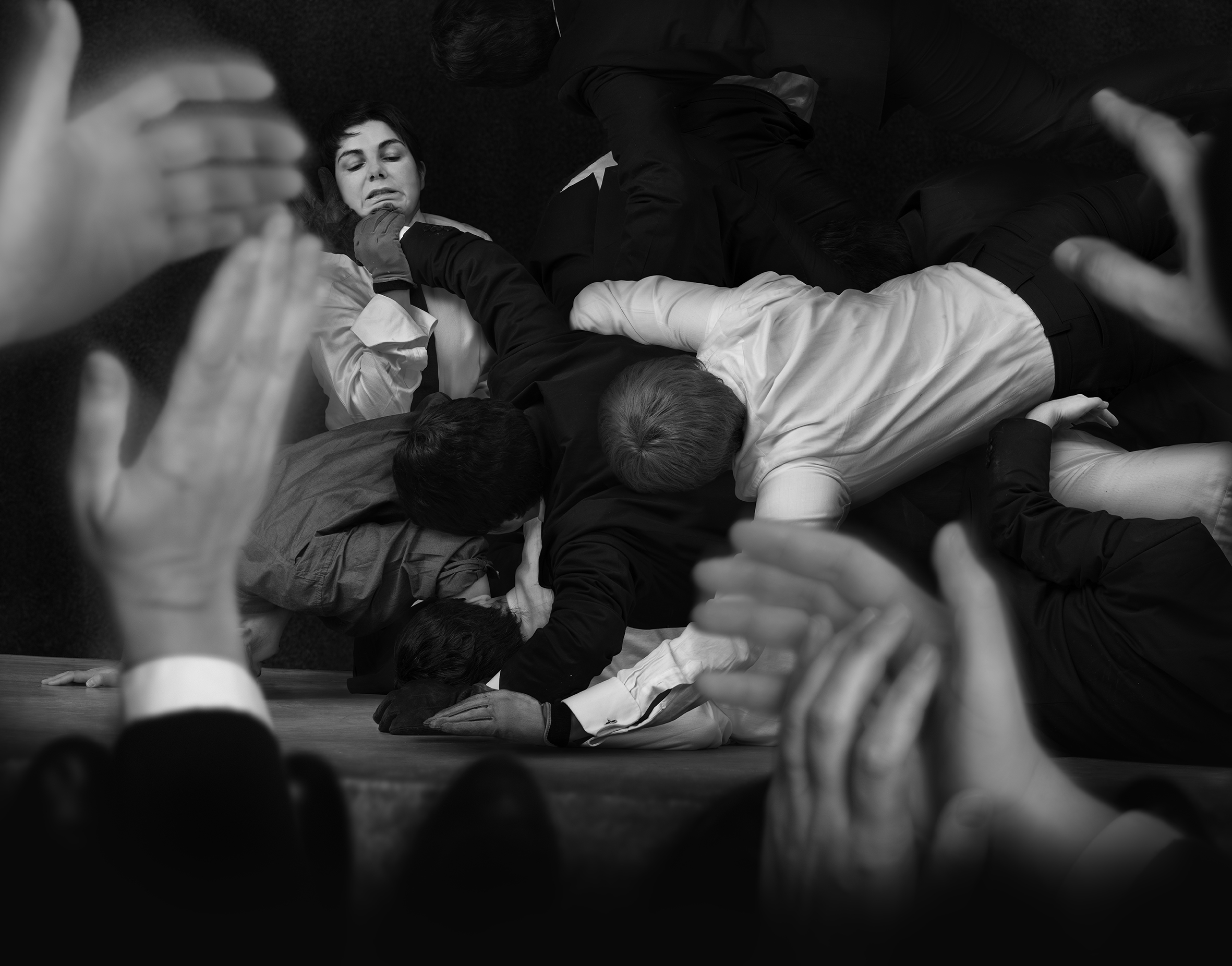
Wall Game I (clap), photographic print, 66x85cm
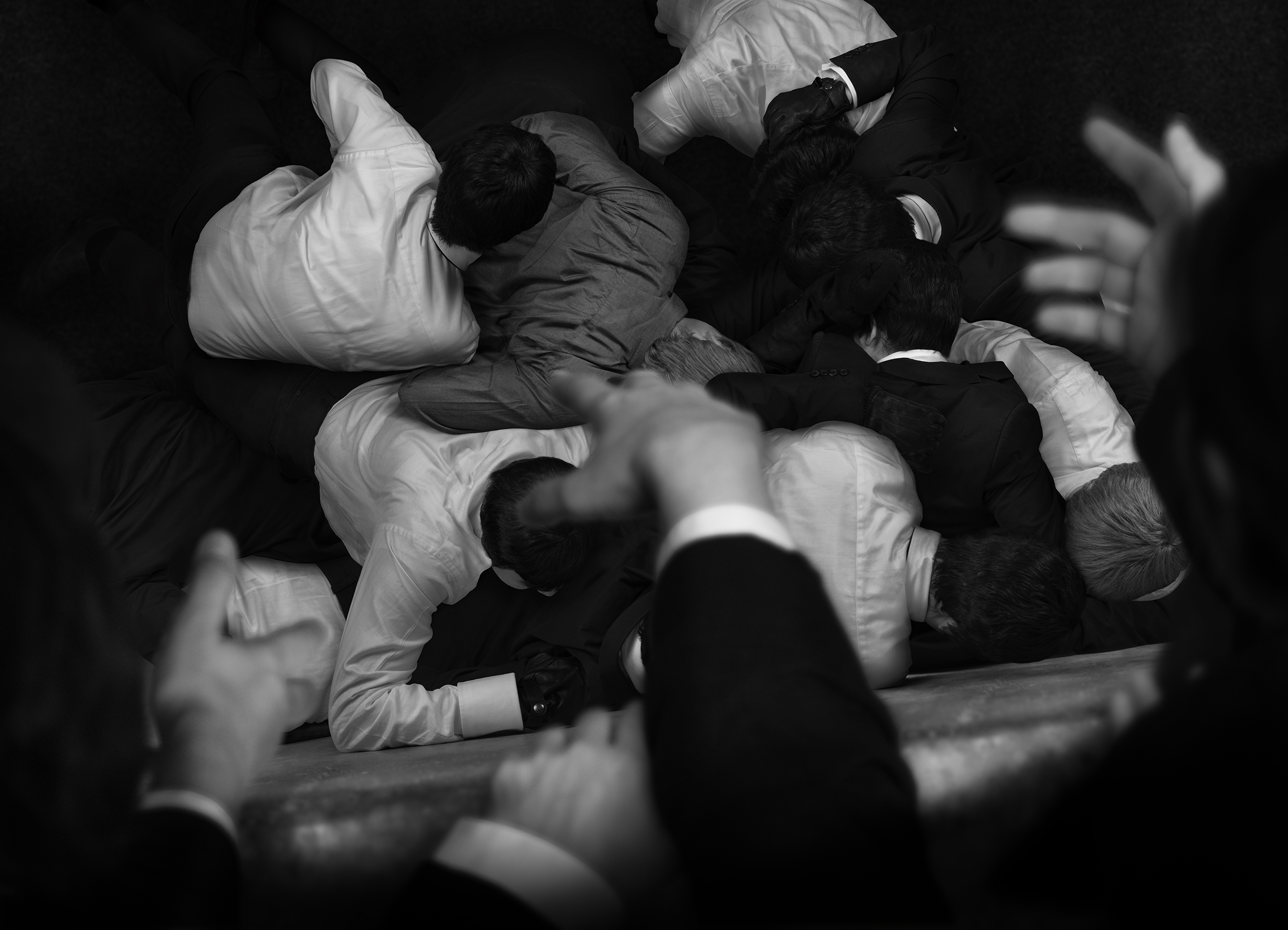
Wall Game II (chequered), photographic print, 66x85cm

Pancake Greaze II (play), photographic print, 55x50cm
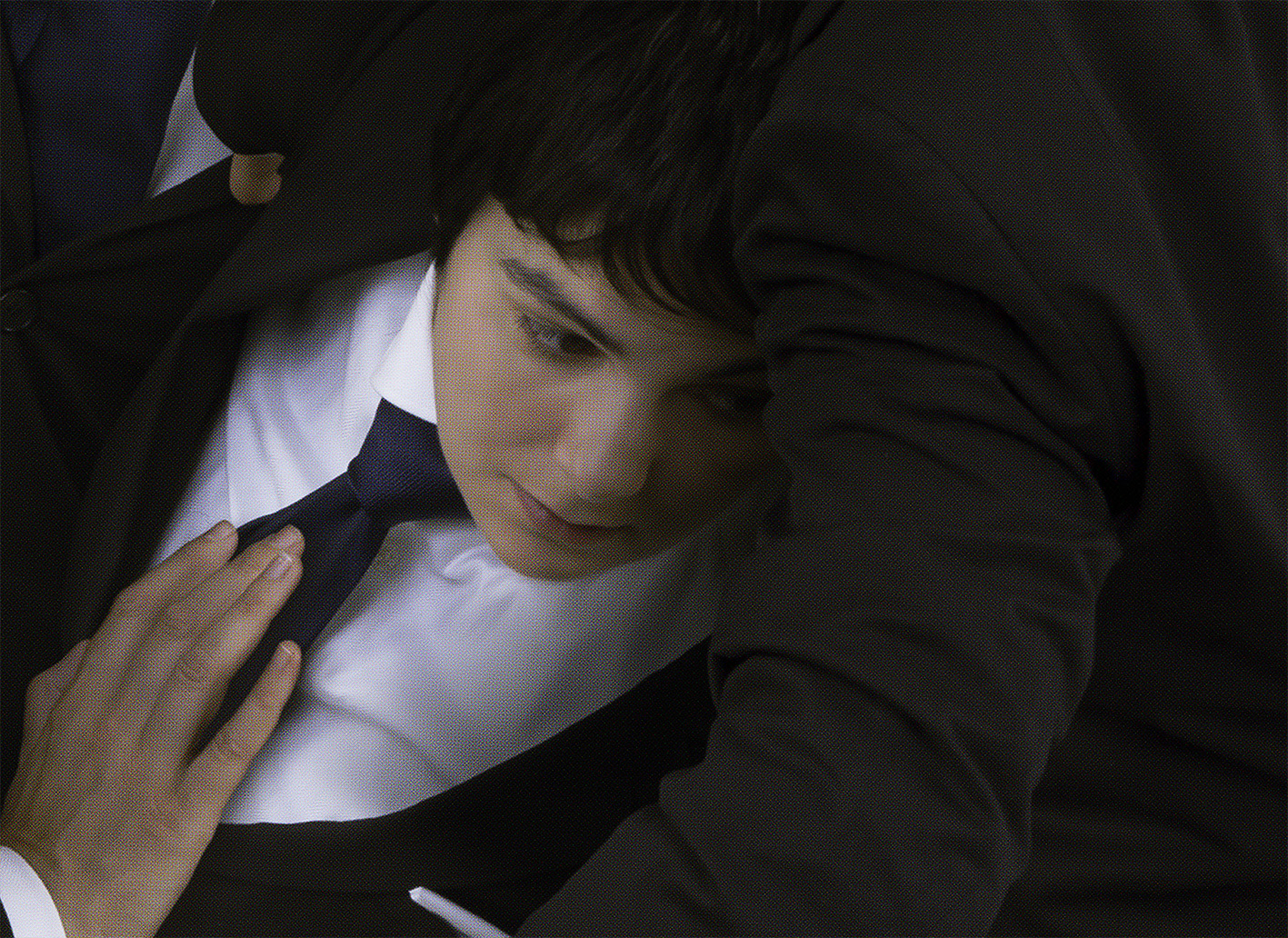
Pancake Greaze III (push), halftone-dot print, site specific
Installation views

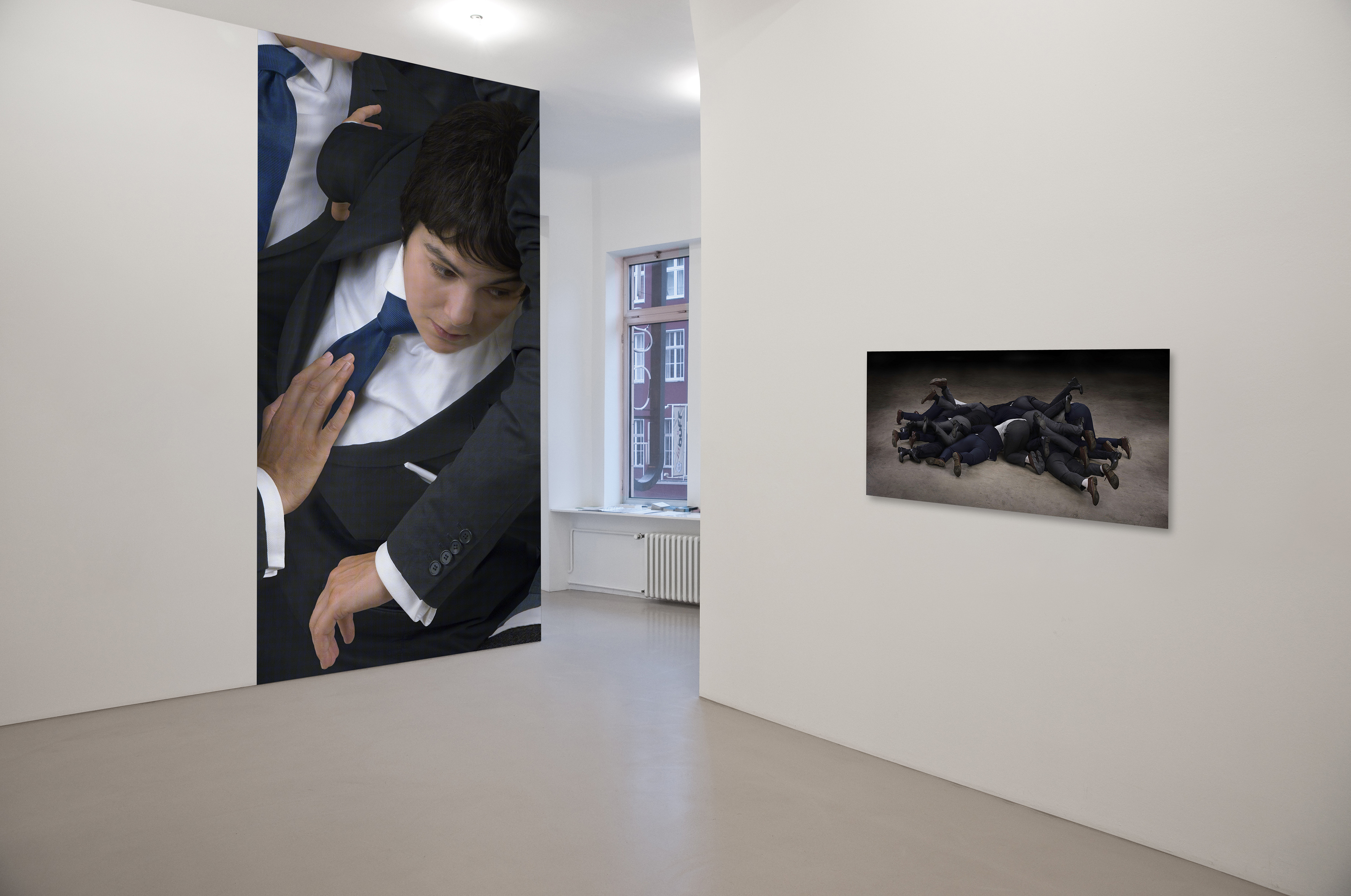


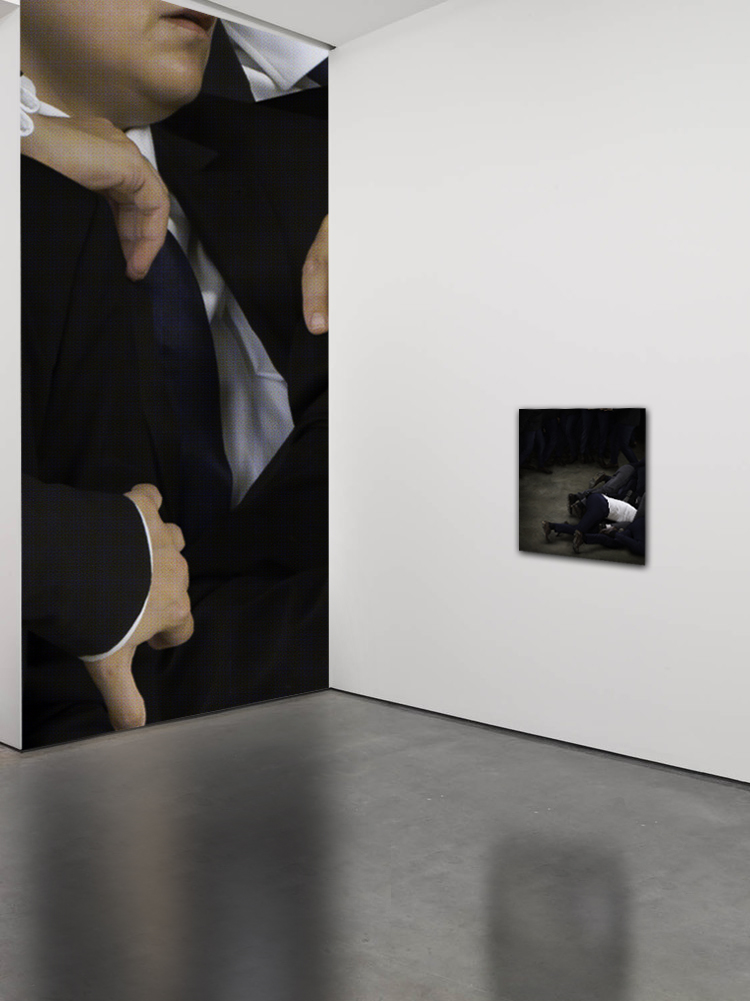
Articles
by Uma Karavadra
Her latest series, The One That Couldn’t Get Away, uses found images of games played in English public schools. Games include Pancake Greaze, which is played at Westminster School where a pancake is tossed in the air and students fight to grab the largest piece, and the Eton Wall game, which resembles Rugby Union.
The photographs emphasise the physicality and conflict of the games, yet there is a humour in the incongruity of boys in suits and ties wrestling for a pancake. Hage subverts the image by replacing the male bodies with her own and as a woman of mixed descent highlighting the power dynamics of the scene. These games have been played for hundreds of years and are part of the tradition and legacy of institutions which have produced a high proportion of Britain’s political elite. Hage is interested in what these traditions tell us about social relations and the values upheld by institutions like Eton, which has educated 19 British Prime Ministers and a number of members of the Royal family.
Tina Hage’s photographs often depict bodies in close proximity, tangled in piles of limbs or jostling for space in a crowd. While these works were created before our current predicament, they recall a not too distant reality, where daily urban life meant being part of a mass of bodies.
Hage’s photographs combine the aesthetics of documentary photography with the making process of painting. She isolates a specific, meaningful moment and re-enacts it by photographing herself in each of the multiple roles and digitally composing it. The compositions draw our attention to the constructed nature of the scene, toying with the idea of supposedly candid photojournalistic images. The re-enactments are based on photojournalistic imagery either taken by Hage or found in a variety of media – often focusing on the social and political content of the imagery.
Her latest series, The One That Couldn’t Get Away, uses found images of games played in English public schools. Games include Pancake Greaze, which is played at Westminster School where a pancake is tossed in the air and students fight to grab the largest piece, and the Eton Wall game, which resembles Rugby Union.
The photographs emphasise the physicality and conflict of the games, yet there is a humour in the incongruity of boys in suits and ties wrestling for a pancake. Hage subverts the image by replacing the male bodies with her own and as a woman of mixed descent highlighting the power dynamics of the scene. These games have been played for hundreds of years and are part of the tradition and legacy of institutions which have produced a high proportion of Britain’s political elite. Hage is interested in what these traditions tell us about social relations and the values upheld by institutions like Eton, which has educated 19 British Prime Ministers and a number of members of the Royal family.
In 2009, Hage was in Beijing towards the end of the SARS outbreak. Whilst traveling on trains she noticed passengers wearing masks, something she was unaccustomed to seeing at the time. During rush hour people were often exhausted and sometimes appeared ill on the crammed trains. Hage would take photographs on these journeys that she later recreated for her Universal Pattern series, which explores the collective as represented in mass media. In Universal Pattern IV, the artist is shown in various states of exhaustion or sleep, wearing a mask or coughing into a tissue.
Mere months ago, the work could be read as depicting the universal discomforts of public transport. Today, it reflects the shared anxiety around sickness and the proximity of bodies, as well as our altered reality where the indignities of public transport are no longer a part of daily life for many. In Hage’s photographs, scenes are symbolic and the crowd functions as a reflection of society. If we look close enough there is a lot the mass can tell us about ourselves.
This article was published by Uma Karavadra on Contemporary Art Society / Artist to Watch
The one that couldn’t get away
by Uma Karavadra
Her latest series, The One That Couldn’t Get Away, uses found images of games played in English public schools. Games include Pancake Greaze, which is played at Westminster School where a pancake is tossed in the air and students fight to grab the largest piece, and the Eton Wall game, which resembles Rugby Union.
The photographs emphasise the physicality and conflict of the games, yet there is a humour in the incongruity of boys in suits and ties wrestling for a pancake. Hage subverts the image by replacing the male bodies with her own and as a woman of mixed descent highlighting the power dynamics of the scene. These games have been played for hundreds of years and are part of the tradition and legacy of institutions which have produced a high proportion of Britain’s political elite. Hage is interested in what these traditions tell us about social relations and the values upheld by institutions like Eton, which has educated 19 British Prime Ministers and a number of members of the Royal family.
Tina Hage’s photographs often depict bodies in close proximity, tangled in piles of limbs or jostling for space in a crowd. While these works were created before our current predicament, they recall a not too distant reality, where daily urban life meant being part of a mass of bodies.
Hage’s photographs combine the aesthetics of documentary photography with the making process of painting. She isolates a specific, meaningful moment and re-enacts it by photographing herself in each of the multiple roles and digitally composing it. The compositions draw our attention to the constructed nature of the scene, toying with the idea of supposedly candid photojournalistic images. The re-enactments are based on photojournalistic imagery either taken by Hage or found in a variety of media – often focusing on the social and political content of the imagery.
Her latest series, The One That Couldn’t Get Away, uses found images of games played in English public schools. Games include Pancake Greaze, which is played at Westminster School where a pancake is tossed in the air and students fight to grab the largest piece, and the Eton Wall game, which resembles Rugby Union.
The photographs emphasise the physicality and conflict of the games, yet there is a humour in the incongruity of boys in suits and ties wrestling for a pancake. Hage subverts the image by replacing the male bodies with her own and as a woman of mixed descent highlighting the power dynamics of the scene. These games have been played for hundreds of years and are part of the tradition and legacy of institutions which have produced a high proportion of Britain’s political elite. Hage is interested in what these traditions tell us about social relations and the values upheld by institutions like Eton, which has educated 19 British Prime Ministers and a number of members of the Royal family.
In 2009, Hage was in Beijing towards the end of the SARS outbreak. Whilst traveling on trains she noticed passengers wearing masks, something she was unaccustomed to seeing at the time. During rush hour people were often exhausted and sometimes appeared ill on the crammed trains. Hage would take photographs on these journeys that she later recreated for her Universal Pattern series, which explores the collective as represented in mass media. In Universal Pattern IV, the artist is shown in various states of exhaustion or sleep, wearing a mask or coughing into a tissue.
Mere months ago, the work could be read as depicting the universal discomforts of public transport. Today, it reflects the shared anxiety around sickness and the proximity of bodies, as well as our altered reality where the indignities of public transport are no longer a part of daily life for many. In Hage’s photographs, scenes are symbolic and the crowd functions as a reflection of society. If we look close enough there is a lot the mass can tell us about ourselves.
This article was published by Uma Karavadra on Contemporary Art Society / Artist to Watch
von Tanja Pol
In ihrer neuen Werkgruppe: The one that could’t get away (2020), einer Reihe großformatiger Farb- und Schwarz-Weiß-Fotografien, bezieht sich Tina Hage auf spielerische Rituale, die an den beiden englischen Eliteschulen Eton und Westminster seit dem 18. Jahrhundert vollzogen werden. Diese stellt sie in einem Reenactment szenisch nach.
Die Künstlerin taucht ein in einen symbolischen Raum, zu dem sie aufgrund ihres Geschlechts und ihrer Herkunft kaum Zugang hat. Die Fotos sind Momentaufnahmen einer Narration, die nah an der Realität, aber dennoch inszeniert ist.
Beim Pancake Greaze der Westminster School in London, der immer am Shrove Tuesday* stattfindet, wirft der Koch der Schule einen Pfannkuchen in Richtung einer Gruppe Schüler. Ziel ist es, unter körperlichem Einsatz ein möglichst großes Stück vom Kuchen zu ergattern. Das in Eton gespielte Wall Game ähnelt dem Rugby.
Bilder dieser beiden Rituale weisen gewisse Ähnlichkeiten auf: Man sieht im Kampf ineinander verkeilte Körper von jungen Männern, dogpiles, aus denen lauter Gliedmaßen hervorschauen, fast gesichtslos. Publikum dieser nicht öffentlichen Spiele ist jeweils die Schulgemeinschaft, aber es kursieren zahlreiche Fotos im Netz aus verschiedenen Jahrzehnten, diese sind Hages Vorlage für ihre eigene fotografische Reinszenierung.
Allen Fotos der neuen Serie von Tina Hage ist gemeinsam, dass die Figuren westliche Männerkleidung tragen: Anzug, Hemd, Schnürschuhe, teilweise Krawatte. Des weiteren ist keine Person vollständig in Ganzfigur gegeben, die zu unterscheidenden Gruppen „Publikum“ und „Spieler“ sind entweder durch den Bildrand angeschnitten, oder die kämpferische Handlung bedingt, dass ein Gesamteindruck von einem Knäuel gesichtsloser Gliedmaßen entsteht. Die Homogenität der Kleidung im Zusammenspiel mit den Körperhaltungen und der Absenz vielfältiger Physiognomien erzeugt Bilder, die extrem verdichtet und stilisiert wirken. Eine Ausnahme bildet hier The Pancake Greaze III (push), welches wie ein Close-up Detail der anderen Bilder wirkt.
Hage setzt gezielt Tiefenschärfe und eine Unterscheidung von Vorder- Mittel- und Hintergrund ein, zum einen, um die Gruppen der Spieler und des Publikums zu unterscheiden, zum anderen, um eine atmosphärische Verdichtung zu erzeugen, die beispielsweise entsteht durch große, klatschende Hände im Vordergrund, die den Betrachter in die Rolle des im Bild anwesenden Zuschauers versetzt. Dieses Moment der Zeugenschaft, ja vielleicht sogar Komplizenschaft in einigen Motiven, wie auch die Hervorhebung von Körperlichkeit vermitteln eine subtile Intimität. Der Wechsel von Close-up zu Überblickssituationen je nach Motiv durchläuft die Serie wie ein Spannungsbogen.
Die Künstlerin komponiert ihre Fotografien oft unter ästhetischen Gesichtspunkten, in dieser Serie besonders deutlich in Wall Game II (chequered). Wie im Titel angedeutet ergibt die Anordnung sehr heller und sehr dunkler Partien im Bild eine Art Schachbrettmuster („chequered“). Auf symbolischer Ebene lässt sich dies deuten als ein Muster im Sinne einer Struktur. In Pancake Greaze I (stack) bilden die kämpfenden Körper eine Art Organismus, wie etwa eine Blüte, ein vielbeiniges Insekt oder Tier mit Tentakeln. Im übertragenden Sinne wird hier visuell verwiesen auf die strukturelle, institutionalisierte Macht in geschlossenen privilegierten Zirkeln. Britische Minister sind in aller Regel Alumni der beiden Schulen, auf die referiert wird. Zugang zur Schule haben insbesondere weiße, männliche Kinder herrschender Eliten.**
Tina Hage verkörpert jede im Bild dargestellte Person in einzelnen Selbstporträts, die sie im Atelier macht, und in einem zweiten Schritt am Computer zum Gesamtbild collagiert. Um eine eingenommene Pose fotografisch festzuhalten, muss sie für einen Moment still verharren, paradoxerweise sind aber die Szenen, die sie nachstellt von größter Aktion und Bewegung geprägt. In der im Originalfoto dargestellten reellen Szene haben sich Männer unter Einsatz des ganzen Körpers übereinandergeworfen, das Foto friert diese Aktion ein, vermittelt sie aber. Dieses Spannungsverhältnis von Bewegtheit versus Starre ist in den Arbeiten wahrnehmbar. Obwohl der Betrachter Körper in wilden, Bewegung suggerierenden Posen sieht, strahlen die Motive auch eine nicht leicht zu fassende Stille aus.
In der Realität beider Schulen sind die Rituale des Pancake Greaze bzw. des Wall Games sehr bedeutungsvoll, denn die Kontrahenten/Mannschaften vertreten verschiedene Gruppen innerhalb des Systems, es geht um Hierarchien im Mikrokosmos Schule und ihre Aufrechterhaltung. Der Ablauf und die Durchführung sowie die Ergebnisse werden sehr ernst genommen. Umgekehrt gibt es ein Phänomen in der Politik, dass Politiker*innen (in der Regel allerdings Politiker, da die Politik nach wie vor ein stark gegendertes System ist) in Krisensituationen aus Bürgersicht agieren wie in einem harmlosen Spiel, das ohne Konsequenzen im echten Leben ist. Dies scheint auch der Fall zu sein für den Politiker, für den Bürger in aller Regel jedoch nicht, im Gegenteil. Dieses Verschwimmen der Grenzen zwischen Spiel und Alltagsrealität wird in der Fotoserie The one that could’t get away sehr subtil, aber eindrücklich inszeniert.
*Shrove Tuesday, auch Pancake Day: „Beichtdienstag“, Dienstag vor Aschermittwoch, also der letzte Tag vor Beginn der Fastenzeit im christlichen Kalender, in anderen Ländern und Kulturkreisen beispielsweise Faschingsdienstag, Karnevalsdienstag oder Mardi Gras genannt.
**Eton ist eine reine Jungenschule. Westminster School war bis 1967 reine Jungenschule, und nimmt heute Mädchen ab 16 Jahren auf, Jungen bereits ab 7 Jahren.
